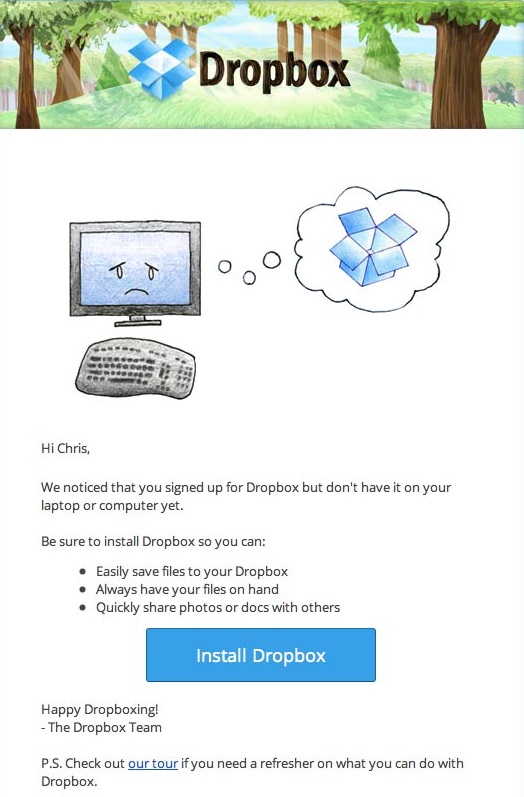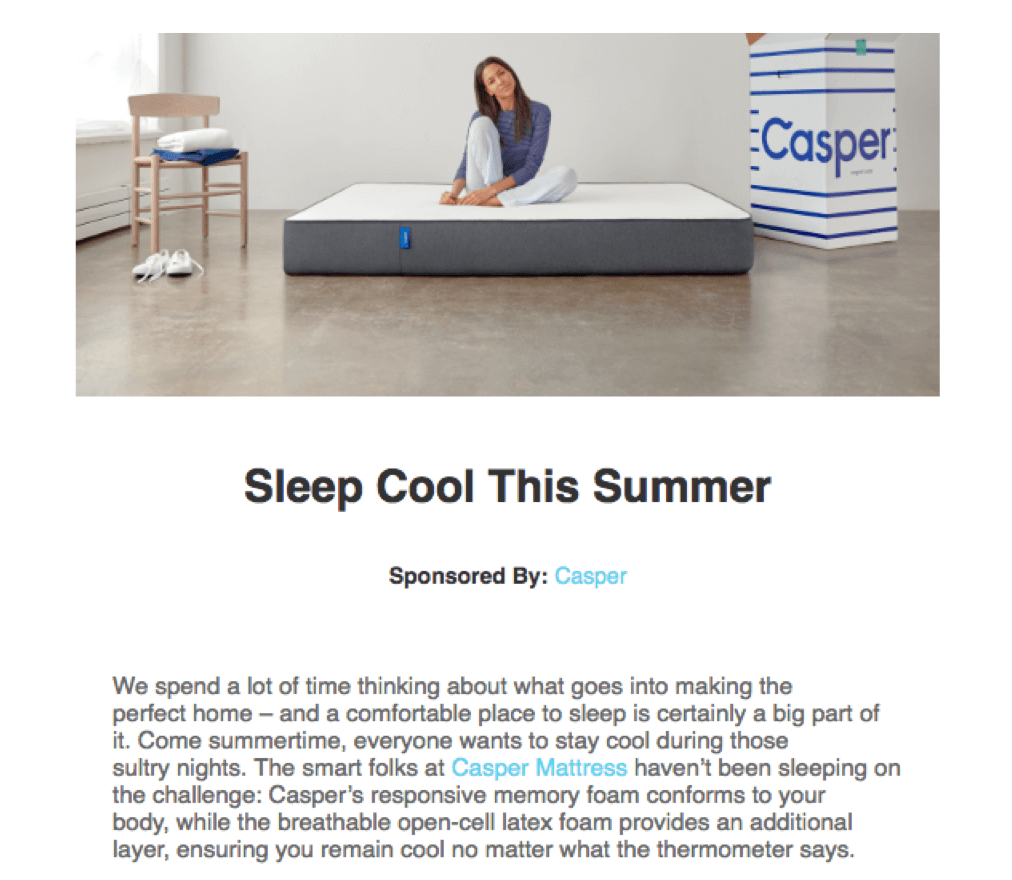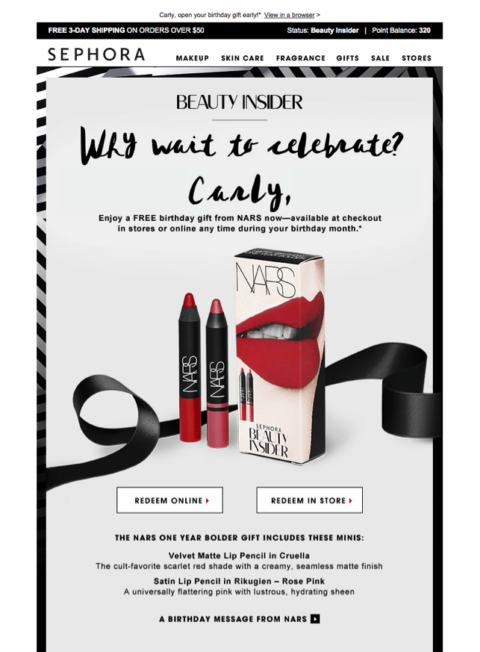Discover top guides, trends, tips and expertise from AIO Writers
18 Types of Emails You Should Send Your Customers
Julia McCoy
Friday, 14th Jul 2023
Email marketing is an essential part of any successful digital strategy.
Emails have evolved from being just a simple tool for exchanging personal messages to widespread usage in business communication. Today there are 4.3 billion email users in the world — more than half the earth’s population.
In commerce, 64% of small businesses use email marketing to reach customers, with 33% of marketers sending weekly emails to communicate with their target audiences.
In this blog post, we’ll discuss the different types of emails you should send your leads and customers to provide helpful information while increasing conversions.
Table Of Contents:
18 Types of Emails You Should Send to Your Customers + Examples
There are many types of emails for different audience segments that serve different purposes.
What are the types of emails you should send to your subscribers?
1. Welcome Emails
The first type of email you should send subscribers is the gold standard: the welcome email.
Greeting new email subscribers leaves a positive first impression and establishes the atmosphere of future interactions with your company. A good welcome email should thank subscribers for signing up while providing them with relevant information such as:
- What they can expect from future communications.
- How often they will receive messages from you.
When thanking subscribers in your email list, make sure the message is genuine and sincere – not just another automated response. This is the perfect opportunity to showcase your company’s personality and create an emotional connection with people in your email list.
In addition to expressing gratitude, you could provide recipients with more information about your business. Some ideas include:
- Introducing key team members.
- Highlighting popular blog posts.
- Offering sneak peeks into upcoming products or services.
- Offering exclusive discounts or promotions only available to those who have signed up for your email list.
Here’s an example of a welcome email I wrote with BrandWell:
Welcome to our Exclusive Circle!
Dear [Recipient’s name],
We’re thrilled to have you on board! 👋 By signing up for our newsletter, you’ve just unlocked a wealth of insights that will keep you ahead in the market. No more endless scrolling – handpicked content, tailored just for you and delivered right in your inbox, now isn’t that a breather? 🌟
So, what’s in the store for you?
- Exclusive Content: Fresh, unique insights that you won’t find anywhere else.
- Early Access: Be the first to know about our latest offerings and updates.
- Tailored for You: Thoughtfully curated content based on your interests and preferences.
We typically send out our newsletter once a week, but if you’d like, you can adjust the frequency in your settings. Your mailbox, your rules!
We look forward to sharing our adventures with you! If you have any questions, please don’t hesitate to reach out. We’re here to cater to all your queries, whether big or small.
Let’s make the most out of this exciting journey together! 🚀
With enthusiasm,
[Your Name]
P.S.: If you ever wish to unsubscribe, just click on the ‘unsubscribe’ link at the bottom of any of our mails. But trust us, you’ll be missing out!
2. Promotional Emails
The primary benefit of sending promotional emails is to increase sales and revenue by offering customers incentives to purchase your products or services. This could be in the form of coupons or discounts that make it more attractive to buy from you vs. competitors.
Promotional emails can also help boost customer loyalty and engagement through exclusive access to content and offers only available through your business.
Lastly, these types of emails can help build brand recognition since they often include images, fonts, and colors associated with your company which will stay in the minds of customers.
There are many types of promotional emails that businesses use depending on their goals. These include limited-time offers (LTOs), flash sales announcements, and holiday specials among others. Each type has its own purpose so it’s important to understand which type of promotional email is best for the occasion.
For example, if you want immediate results, then an LTO might be best. Whereas if you want long-term growth, then a newsletter may be better suited for this goal.
For example:
Special Offer Just For You!
Hey [Recipient’s name],
We are super excited to announce a limited-time offer exclusively for you. Yes, you heard it right! We want to say a big thank you for being such an integral part of our community. 👏
As a token of our appreciation, we are offering a generous 20% discount on our premium range of products. But hurry, this offer is valid only until [end date]! 🎁
Wait, there’s more!
- No Shipping Costs: Enjoy free delivery on us, no matter where you live.
- Freebies Galore: Delight in surprise freebies that come with every purchase.
- Loyalty Rewards: Keep adding points to your loyalty account with every purchase. Remember – points mean prizes!
Sounds tempting? Get started now and make the most of this amazing deal. Simply use the promo code THANKYOU20 at checkout and watch the magic happen. 🌟
If you have any questions regarding this promotion, our customer service team are ready and happy to help. Get in touch today and make the most of your exclusive offer!
Don’t sit back. These deals are flying off the shelves! Shop now and bask in the happiness of saving! 🛍
Hurry! Your exclusive offer is just a click away!
Happy shopping,
[Your Name]
Remember: Use code THANKYOU20 at checkout. Offer expires on [end date].
3. Newsletter Emails
Email newsletters are a great way to engage with your audience, build relationships, and keep them informed about what’s happening in your business.
But, creating an effective newsletter isn’t as easy as it sounds. In fact, these types of emails take careful planning and thoughtful content to ensure that you get the most out of each issue.
You may want to consider sending out weekly newsletters on specific topics related to your industry – like tips & tricks or case studies – so readers have something interesting and informative waiting in their inboxes each week.
Before launching a newsletter, do some research into the industry you’re targeting. See if newsletters are common practice in this space and take note of what other companies are doing with their own newsletters — what type of content they put out and how often they send them. This will give you a better idea of what works (and doesn’t) when it comes to crafting an effective email newsletter for your own company.
When creating your weekly newsletter content, focus on quality over quantity. Stick to one topic per issue so readers don’t feel overwhelmed by too much information at once.
Consider including helpful tips related to the product or service you offer, interesting facts about your industry, a behind-the-scenes look at how things work in your business or organization — anything that adds value for readers. Keep track of which types of content perform best so that you can continue producing engaging material for future issues.
Give readers opportunities to interact with the content by adding polls or surveys where appropriate. Ask questions throughout the body copy. Provide links to additional resources like blog posts or whitepapers.
Lastly, add social media buttons so subscribers can easily share your articles, and include a strong call-to-action to encourage people to act after reading through an issue.
Master the craft by learning how to write a newsletter.

Screenshot of Moz’s semi-monthly newsletter
4. Re-Engagement Emails
Re-engagement emails are an important part of any email marketing strategy. These types of emails can help bring back inactive customers and get them interested in your product or service again.
These types of emails typically focus on providing incentives or special offers that will encourage the customer to come back and make a purchase.
The first step in creating effective re-engagement emails is identifying which customers have gone inactive. Look at data on open rates, clickthrough rates, purchases, and website visits so you can determine who hasn’t been engaging with your brand recently.
Once you have identified these customers, you can then create targeted campaigns specifically designed for them. This way, you won’t be wasting time sending messages to people who aren’t likely to respond anyway.
Another key element of successful re-engagement emails is personalization. You want the message to feel like it was written just for the recipient – not just another generic email blast sent out en masse.
Include their name in the subject line or body of the email and use language that speaks directly to them. Mention any past purchases they may have made and offer discounts based on their previous buying habits.
When you send emails for re-engagement, try using words like “limited time only” or “hurry before supplies run out!” This helps create a sense of urgency around your marketing emails to prompt recipients to take action now.
If possible, include a countdown timer showing exactly how much time there is left before the offer expires – this has been proven to increase conversions significantly compared with regular non-urgent messages!
Here’s an example written by BrandWell:
Hey, We Miss You!
Dear [Recipient’s name],
We couldn’t help but notice that it’s been a while since we last saw you. We miss your presence in our community and we hope everything is well with you. 💔
We understand you might be busy, but we just wanted to remind you of the fabulous world of beauty you’re missing out on. At [Company’s Name], we’re constantly innovating and curating to keep you at the forefront of the beauty world. And we’ve missed having you on this exciting journey!
Well, the beauty world waits for no one, so to get you back on track, we have a special offer tailored just for you:
Unleash your inner beauty with a stunning 30% discount on your next purchase!
To avail this, simply use the promo code: WEMISSYOU30 during checkout.
This is the perfect chance to get your hands on that eyeshadow palette you’ve been eyeing or try out our new range of lipsticks. 💄 But act fast – this exclusive offer is valid only till [end date]!
We sincerely hope this mail finds you in good health and high spirits. Please feel free to catch up and tell us all about what you’ve been up to. We would love to hear from you! 💌
Stay gorgeous, always!
[Your Name]
Note: It’s okay if you need a little more time, if you want to change the frequency of our communications, or even if you need a break. Please let us know, and we’ll adjust accordingly. Your happiness is our priority. 😊
5. Transactional Emails
Transactional emails are types of emails that provide subscribers in your email list with timely and relevant information about their purchases or account activity.
Transactional emails can also help businesses track user behavior and preferences so they can better target their marketing campaigns in the future.
Common examples of transactional emails include:
- Order confirmations.
- Shipping notifications.
- Payment receipts.
- Password reset requests.
- Subscription renewal reminders.
- And more.
Confirmation emails are usually triggered by a specific action such as making a purchase or changing an account setting.
For example, when a customer makes an online purchase on your website, you could send them an email confirming that their order has been placed successfully along with details like an estimated delivery date.
Similarly, when a subscriber’s password is changed, it is customary to send them an email notifying them of this specific action to prevent unauthorized access to their account.
Here’s an example of a transactional email for shipping notifications:
Your Order is on the Way!
Hello [Recipient’s name],
Great news! 🎉 Your order #[Order number] has been dispatched and is now happily en route to its new home – yours! 🏡
Here are some details:
- Dispatch Date: [Dispatch Date]
- Estimated Delivery Date: [Estimated Delivery Date]
- Shipping Provider: [Shipping Provider]
- Tracking Number: [Tracking Number]
To track your order, simply click on the button below:
Track My Order
Meanwhile, why don’t you start making some space for the new arrivals? They can’t wait to meet you! 🎁
If you happen to have any queries or concerns, do not hesitate to reach out to our support team – we’re always here to help.
Thank you again for shopping with us. We appreciate your patience and can’t wait for you to receive your order.
Safe travels to your order,
[Your Name]
P.S.: Remember, you can track your parcel’s progress at any time using the tracking number above!
6. Abandoned Cart Emails
Abandoned cart emails can be used as a reminder for customers who have left items behind in their shopping carts, encouraging them to complete the transaction.
Leftover items in the shopping cart can be recalled with these types of emails, prompting shoppers to follow through with their purchases. Abandoned emails should be tailored based on the recipient’s purchase history and include personalized recommendations that may spark an impulse buy or further engagement with your brand.
Messages of this kind can also provide you with useful information about customer behavior, which can help devise a more effective email strategy in the future. For instance, if you find that most people who abandon carts do so because of expensive shipping costs, you could adjust your pricing structure or offer free shipping vouchers for certain orders over a certain amount.

Screenshot of Dollar Shave Club’s abandoned cart email series
7. Progress Update Emails
Progress update emails are an effective way to reach out to inactive subscribers in your email list and keep them in the loop.
Major changes like new product launches and updated branding initiatives should be highlighted, but even small wins such as hitting certain social media follower counts deserve recognition too. You can use these emails to show off how far you’ve come while also keeping your email lists engaged and informed.
When announcing progress updates to your email lists, make sure that each message is tailored to the recipient and contains relevant information that resonates with them.
Start by thanking subscribers for their loyalty and interest in what you do – this helps establish trust from the get-go. Then move on to providing clear details about any accomplishments or developments that have occurred recently, whether it’s launching a new product line, celebrating an anniversary milestone, or just hitting a certain number of followers on Twitter. Let people know why they should care.
Sending out regular progress update emails is essential for keeping your email list engaged and informed about all of the exciting things happening at your company. When done right, these types of messages can be powerful tools for boosting customer loyalty while driving sales growth at the same time. So don’t forget about them when creating your email marketing strategy.

A product update email from Airtable
8. Lead Nurturing Email Sequences
Lead nurturing emails are an important part of any successful email strategy. These types of emails are designed to build relationships with potential customers and keep them engaged in the sales process.
The main benefit of lead nurturing emails is that they help you stay top-of-mind with prospects who may not yet be ready to buy but could potentially become loyal customers down the road if nurtured properly through these email campaigns.
These types of messages allow you to track engagement levels so you know exactly where each individual prospect stands in terms of interest level and readiness to buy.
Lead nurturing emails can be an effective way for businesses to build relationships over time. In contrast, relying on one-off promotional offers often has limited success.

Screenshot of a lead nurturing email from Sephora
9. Survey Emails
Thanking customers for their loyalty is a great way to show appreciation and encourage them to continue engaging with your business.
The best way to thank customers is through an email survey that includes questions about their experience with your product or service. This will give you valuable feedback that can be used to improve the customer experience and increase conversions.
When creating a survey email, make sure it’s personalized and contains clear instructions on how long the survey should take and what type of information you are looking for. You can also offer incentives such as discounts or free products in exchange for completing the survey.
Include questions that address specific areas of improvement. This way, you can get direct feedback from your customers on how they feel about certain aspects of your business or product offerings.
You can also ask open-ended questions to allow your customers to provide more detailed responses than simply choosing from multiple-choice options.
Asking follow-up questions based on their initial response helps draw out further details while allowing customers to share their thoughts in greater depth.
Finally, don’t forget to end each question with an actionable suggestion so respondents know what kind of changes could result from sharing their opinions. This encourages engagement even after they submit the survey.

Screenshot of a feedback email from Fiji Airways
10. Retention Emails
Retention emails play a pivotal role in keeping your customers engaged. By sending targeted messages that resonate with your mailing list, you remind customers not just that you exist but also offer value they shouldn’t miss out on. Whether through milestone celebrations, review requests, or simple reminders to revisit your site, these communications help cement customer loyalty.
11. Educational Emails
Educational emails go beyond mere promotion; they aim to inform, teach, and add real value to your subscribers’ lives. By focusing on delivering content that answers questions or solves problems, you can significantly enhance your relationship with your audience.
In an age where information is abundant but attention spans are short, providing concise yet informative content can set your brand apart. Educational emails show that you’re not just after sales but are genuinely interested in offering something beneficial to your readers. This approach not only helps in building trust but also positions you as an authority in your field — a critical factor for long-term success in any content marketing and SEO endeavor.
Here are some of the best types of education emails you can send to your customers:
- Tutorials and How-tos: Step-by-step guides addressing common challenges related to your industry or product use.
- Industry Insights: Updates on the latest trends, research findings, or changes within the market that could affect how customers engage with products/services like yours.
- Casual Message Blogs Posts: Sharing popular blog posts from your website that provide valuable insights or tips relevant to their interests.
Look at this example written by BrandWell:
The Secrets to a Well-Trained Dog
Hi [Recipient’s name],
If you’ve ever wondered why some dogs seem to be so well-behaved while others seem to be more unruly, you’re not alone. The simple truth? Good training! 🐶
Today’s lesson is all about ‘Consistency’ – the unsung hero of effective dog training.
The Role of Consistency in Dog Training
In dog training, consistency is key. Why? Because dogs learn through repetition. The more consistent you are in your commands and rewards, the easier it is for your furry friend to understand what you expect from them.
Here’s how you can incorporate it into your training routine:
- Stick to the Commands: Once you have chosen a command for a behavior, use it consistently. Changing the command can confuse your dog and delay the training process.
- Be Regular: Training sessions should be regular – even if they’re short. A few minutes of training every day can make a big difference over intermittent, longer sessions.
- Consistent Rewards: Reward your dog immediately after they perform the right behavior. This immediate reinforcement helps them connect the action with the reward, making it more likely they’ll repeat the action.
Remember, patience is vital during this journey. All dogs learn at their own pace, so make sure you’re as consistent with positive reinforcement as you are with the training itself!
We hope this lesson has given you some valuable insights into the world of dog training. Stay tuned for our next mail where we’ll explore another key ingredient of a well-trained dog.
Happy Training!
[Your Name]
Professional Dog Trainer
P.S. Want more tips on dog training? Feel free to reply to this email with any specific questions or topics you’d like us to cover. We’re here to help you and your dog navigate this journey together.
12. Dedicated Emails
Dedicated emails, also known as standalone emails, serve a single purpose or promote a specific offer without any additional information or distractions. Unlike regular newsletters or transactional emails that might cover multiple topics or actions, dedicated emails concentrate on one message which could be about a new product launch, an exclusive offer email, or an invitation to participate in a survey email.
The main advantage of sending dedicated emails lies in their ability to deliver focused content directly aligned with the recipient’s interests or actions. This direct approach helps cut through the noise of crowded inboxes by providing clear value propositions that encourage recipients to take a specific action—be it purchasing an exclusive promotional offer or participating in feedback via review request emails or survey emails.
Example of a dedicated email
13. Announcement Emails
An announcement email is a message sent to a group of recipients to inform them about a specific event, product launch, promotion, or any other important news related to a business or organization. This type of email is typically concise, focused, and designed to grab the reader’s attention quickly.
The goal of an announcement email is to deliver important information effectively while encouraging recipients to take action based on the announcement. A well-crafted announcement email can be a powerful tool for generating interest, engagement, and conversions in email marketing campaigns.
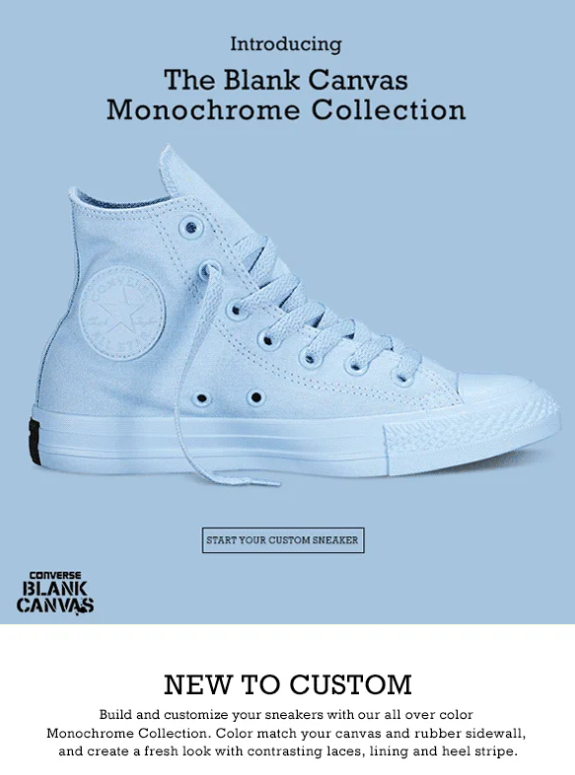
14. Event Invitation Emails
Event invitation emails stand out as an effective method to connect with your email list on a more personal level. Crafting compelling invitations not only excites recipients about upcoming events but also significantly boosts your overall email marketing strategy.
Sending personalized event invitations can make your subscribers feel valued and special. Unlike generic promotional emails or broad newsletters, event invites offer a unique opportunity for lead nurturing by inviting email subscribers to participate in something exclusive. This could range from webinars and product launches to live workshops and signing tours — each serving as a platform for direct engagement and brand reinforcement.
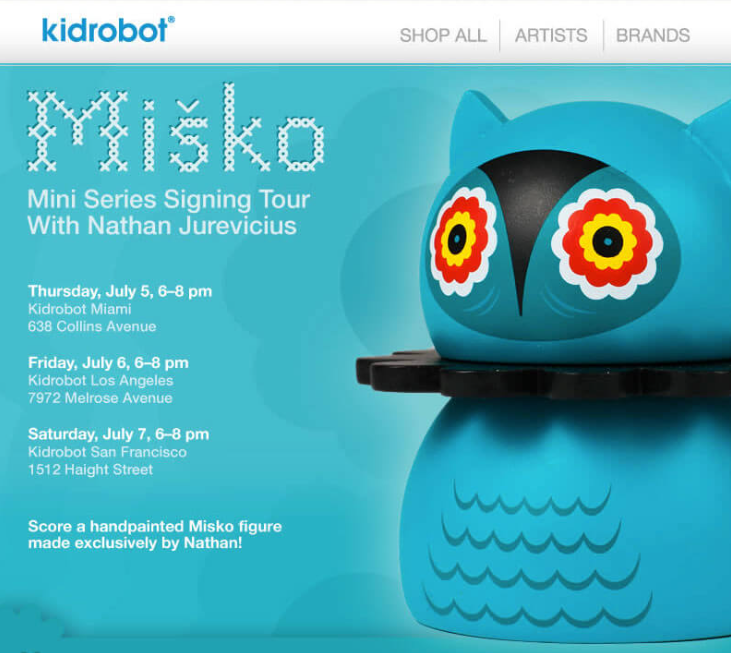
Screenshot of an event invitation email from Kidrobot
15. Seasonal Campaign Emails
Among the many ways to engage your email list, seasonal campaign emails stand out for their ability to connect with subscribers in a more personal and timely manner. These campaigns leverage seasons, holidays, or significant events throughout the year to create highly relevant and engaging content for your audience.
Seasonal emails are not just another message in your subscriber’s inbox; they are an opportunity to celebrate shared moments. Whether it’s a festive holiday greeting, an end-of-season sale announcement, or a reminder about daylight saving time changes, these emails show that you’re paying attention to what’s happening in your customers’ lives outside of just trying to make a sale.
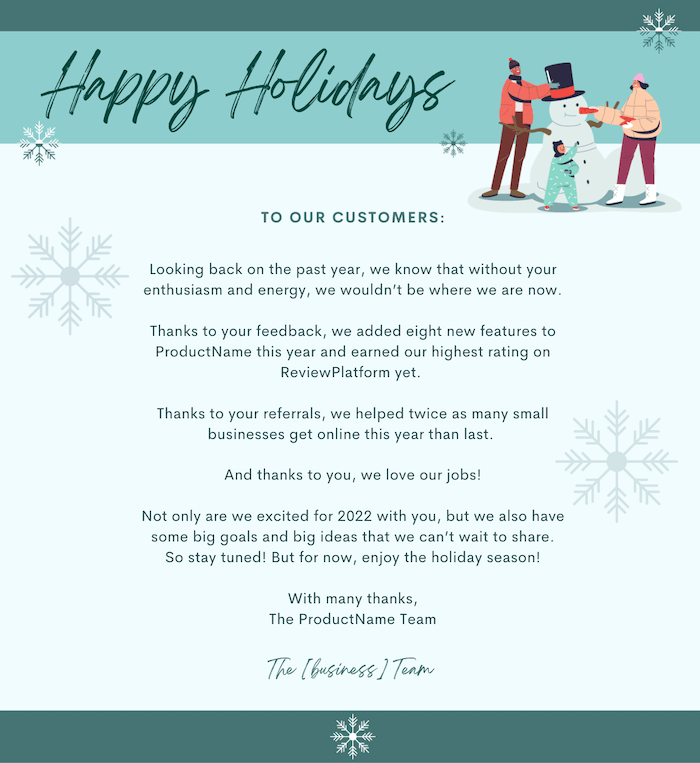
16. Birthday Email
Birthday emails stand out for their personal touch and direct connection to the customer. These milestone emails are more than just a simple email; they’re an opportunity to make your customers feel valued on their special day.
Sending a birthday email is an excellent way to remind customers that you value them as individuals, not just as sources of revenue. It helps in nurturing your relationship with them, thereby increasing loyalty and potentially boosting sales through personalized offers.
Moreover, these emails show impressive engagement rates since they’re relevant and arrive on a significant date for the recipient.
17. Cold Outreach Emails
Cold outreach emails are messages sent to individuals or businesses with whom you have no prior relationship or connection. The purpose of these emails is to initiate contact and start a conversation, often for sales, marketing, or networking purposes.
Examples of cold outreach emails include:
- Sales Outreach: Introducing a product or service to a potential customer who fits your target audience.
- Networking: Reaching out to industry professionals or potential collaborators to build connections and explore opportunities.
- Recruitment: Contacting potential candidates for job opportunities or partnerships.
When done thoughtfully and respectfully, cold outreach emails can be an effective way to expand your network, generate leads, and build relationships with new contacts. However, it’s important to be mindful of the recipient’s preferences and avoid spammy or generic approaches that may turn them off.
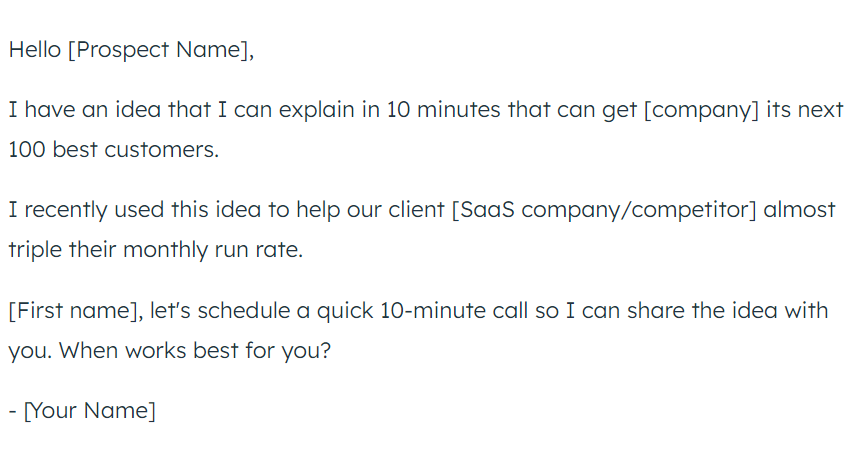
18. Review Requests
In today’s digital age, reviews are gold. Positive feedback from existing customers can significantly influence the decision-making process of prospects. By sending out review request emails, you remind customers of their recent purchases or experiences with your brand and encourage them to share their thoughts online.
An effective email strategy that includes requesting reviews will not only enhance your business’s reputation but also improve its visibility online. Remember, every positive review contributes directly to strengthening your brand image across social media platforms and search engines alike.
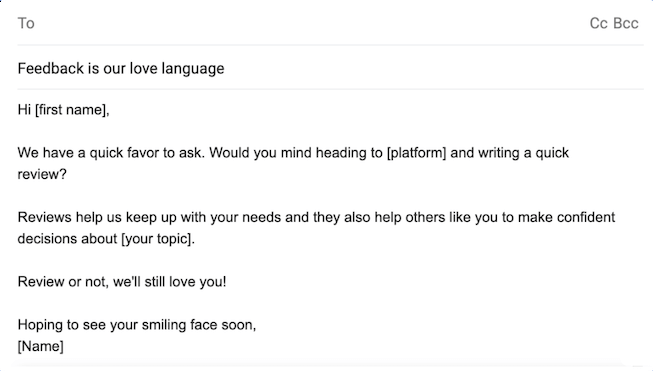
Now that you’re armed with a boatload of knowledge about the different types of emails you should send, it’s time to put these lessons into action.
Read our comprehensive guide on how to write an email that drives results. We’ll also teach you how to write the perfect follow-up email in case your first letter doesn’t get a response.
How do you run an email marketing campaign and make it work?
First things first, remember the golden rule: know thy subscriber. Analyze their preferences and behavior patterns before deciding which types of emails to send.
The timing for sending out promotional emails might differ from lead nurturing or milestone emails.
A study shows that Tuesday at 10 AM is often considered the best time to send promotional emails.
Sending anniversary emails on the actual day can make subscribers feel extra special.
Try to avoid sending emails during peak business hours or busy times when people are likely to be overwhelmed with work and less likely to engage with their inboxes. This can vary depending on the industry and the type of audience you are targeting.
If your target audience spans multiple time zones, consider segmenting your email list based on geographic location and sending emails at appropriate times for each segment. Many email marketing tools offer features to schedule emails based on recipients’ time zones.
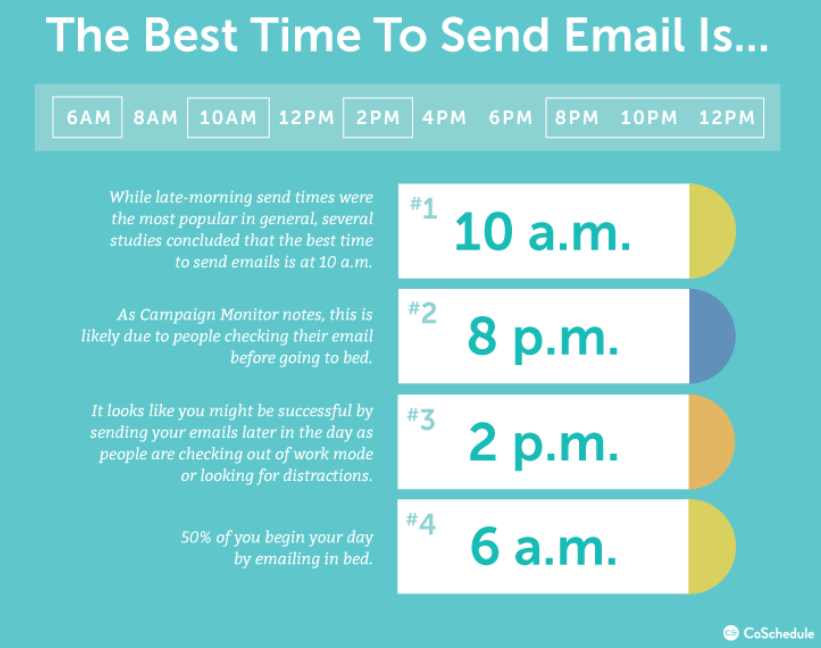
Source: CoSchedule
With the prevalence of smartphones, many people check their emails on mobile devices throughout the day. Therefore, consider optimizing your emails for mobile and testing different times to capture mobile users’ attention.
Conclusion
Email marketing is a powerful tool for businesses, no question.
There are different types of emails you should send to your customers at different stages of the buyer journey.
- Transactional emails keep customers informed about their purchases.
- Email newsletters provide regular updates on products or services, promotional emails drive sales.
- Lead nurturing emails increase customer loyalty.
- Survey emails also play an important role in email marketing campaigns by providing valuable feedback that helps shape future strategies.
The easiest way to stay on top of the email-sending game is to use an automation platform. For example, BrandWell has a specialized chatbot called AIMEE that can help you send various types of emails for different purposes. It automates the creation of personalized emails to engage and nurture your audience, from welcome letters to re-engagement campaigns.
For instance, it can be used to send welcome emails to new subscribers, offering them a warm greeting, great resources, and a unique discount to promote continuing interaction with your company.
Ultimately, by learning how to write different types of emails, you can maximize the effectiveness of your communication efforts with prospects, leads, and customers.

UNLOCK YOUR POTENTIAL
Long Headline that highlights Value Proposition of Lead Magnet
Grab a front row seat to our video masterclasses, interviews, case studies, tutorials, and guides.

